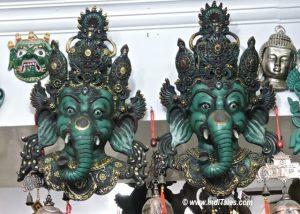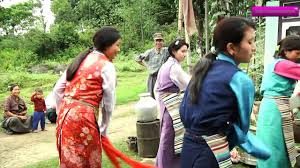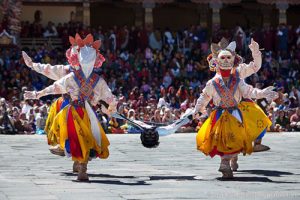Handicrafts of Sikkim
- Traditional arts and handicrafts have been the very breath of Indian Civilization visa-vis Sikkim too.
- Significantly, Sikkim is also known for its traditional handicrafts, paintings, motifs, carpet, traditional tribal shoes, dresses, ornaments, weaving, and so on.
- The traditional handicrafts in Sikkim had has enormous cultural significance.
- Many of the Bhutia and Lepcha as well as Nepalese are engaged in traditional handicrafts production of Sikkim.
Handloom Weaving of Sikkim
- In ancient times, the Lepcha’s of Sikkim were said to use yarn spun out of stinging nettle (sisnu) plant to weave clothes.
- Today cotton and woollen yarn are used together with vegetable dyes and synthetic colours.
- Lepcha weaves or ‘thara’ is woven in vertical looms with a backstrap. Such looms are of small width.
- Traditional design with different colours are used to make tharas which are used for making bedspreads, bags, belts, curtains, cushion covers, table mats, tray cloths etc, apart from their traditional dress.
Woodcarving of Sikkim
- It is one of the most important crafts of Sikkim.
- Traditionally, only the Buddhists Bhutias and Lepchas used to practise wood carving. Indeed, wood carving is an ancient art form of both the Lepchas and Bhutias of Sikkim.
- The items of woodcraft having wide range of variety can be found from household items to partitions to eight Buddhists lucky signs.
- Woodcrafts are available in the following shapes choktse or table, almirah, sofa-sets, drawers or bhodin , screens, lamp stands, cheosum or altars, wall decorations, etc.
Wooden mask of Sikkim
- One of the most important materials items of Buddhists’ traditional culture that has special socio-religious significance is wooden mask of various types being used during their religious dances by the Lamas.

- The masks are carved out of the tough light wood of the giant climber called Zaru-shing, mostly found in the high altitude areas of Sikkim.
- While in Tibet they were composed of mashed paper and cloth.
- In all cases they are beautifully painted and varnished, and are provided with yak tail wig.
- Each mask has a specific meaning and a story with certain religious connotation associated Various Wooden Masks with it.
- Traditionally the mask dances are staged by the Lamas or monks in the Gonpas or Monasteries.
- Such dances are normally performed only by men in the monasteries.
- There are different types of mask normally made by Bhutias and Lepchas like mask of Khangchendzonga, mask of Garura, mask of Mahakal, etc.
Thangka Painting of Sikkim
- The important Thangka is a paintings of divinities or group of divinities on silk clothes which depicts different incarnations and life of Lord Buddha, Goddess Doma (Tara), Guru Padmasambhav or God Chana Dorji or for that matter, any Tibetan saint, wheel of life (one of the purest Buddhists emblems) or some other deity, surrounded by deities of lesser significance etc.
- Thangkas are the religious scrolls found hung in monasteries and houses of Buddhists.
- It has an excellent tradition in Sikkim.
- Such paintings are considered very auspicious and are supposed to drive away evil spirits.
- Thangka painting is a renowned art of Sikkim.
- “The Thangka works of master craftsmen sell for thousands of rupees abroad. They work in seclusion in remote villages” as cited by exgovernor of Sikkim namely Taleyarkhan (1981)
Cane and bamboo work of Sikkim
- It is also the traditional handicraft Bhutias, Lepchas and Nepalese of Sikkim.
- Cane and bamboo pieces are first of all split by using simple tools like Khukri or knife to make thin strips.
- Thereafter the strips are sized as per requirement and are then intricately woven and modified and improved upon as per the graphical design.
- There are varieties of cane and bamboo-craft products like, fruit, baskets, bamboo flower sticks bear mugs, hair clips, tea-trays, tea strainers, spoons, flower vases, piras, mats, hats and tumblers.
- In Sikkim bamboo grows in abundance. But the cane is grown only in limited areas; thereby bulk of it comes from neighboring Siliguri or other parts of the North East.
Preparation of Lucky signs of Sikkim
- Another important handicraft is the ‘Lucky signs’ mostly made by women in Sikkim.
- The lucky signs are made by adopting two types of methods
- one type of embroidery work done by using needle on silk or ‘sharteen’ clothes
- Another is the paintwork (fabric) on silkl’shirteen’ clothes.
- Such lucky signs are presented either in the form of words or symbol. It is used as wall hanging and means the ‘symbol of peace’.
Hand-made paper making of Sikkim
- It is another important handicraft item.
- Apart from other units, there is another important section namely Handmade – paper unit in the Government Institute of Cottage Industry at Gangtok, Unit was opened in the year of 1962.
- Handmade paper, namely ,
- Rayon paper (used for rapping);
- Rags paper (used for making files);
- Card sheet (used for making greeting cards and paper bag).
- Raw materials are used to be brought from Kolkata.
Carpet Weaving of Sikkim
- Traditionally, carpet (locally known as Den) weaving is a symbol of cultural expression in the state of Sikkim.
- Besides, Carpet is very important export oriented handicraft industry in Sikkim.
- The carpets are of with various exquisite and intricate designs, motifs and colours which are typical of Sikkimese type and made of various sizes.
- The price ranges vary according to size and quality of the particular carpet. Carpet weaving is dominated Carpet product by women.
- Though it is a traditional activity, very few families follow it as apart of family tradition.
Blanket Weaving of Sikkim
- It is also one of the traditional handicrafts of Sikkim
- It is normally done by women particularly in North Sikkim.
- The blankets are woven on loom, and the raw materials are available in local market.
- There are mainly two sizes of blanket available i.e. 4 ft. by 6ft. and 4 ft. by 7 ft.
Soft Toys of Sikkim Supported by Sikkim Government and GoI
- The Soft Toys Production unit of the Directorate of Handicrafts and Handloom, Zero Point, Gangtok is one of the prominent sectors for support and creation of self employment in Sikkim.
- This sector is being re-energized into a home to home industry through a project initiative namely “Production and Training for Soft Toys at Gangtok, Sikkim “funded by the North Eastern Council, Ministry of Home Affairs, Government of India and also Government of Sikkim.
- The toy making craft is an activity that can supplement and contribute to the family income and also create self employment.
- The focus of the department is therefore to facilitate continuous capacity building and skill upgradation in this sector and thereby create a resource base of trained manpower.
- Quality standardization and product diversification are two important areas of focus and therefore the best raw materials for creation of quality products are being used in the training centres.
- The training module has been oriented in such a manner so as to emphasis and promote products that are closely connected with the environment and also identify with the local ethos.
- Our main motto is to offer quality products to our valued customers at competitive prices.
- The Soft Toys Sector provides self employment and income to the large number of artisan in terms of quality and cost comparativeness of the soft toys products of DHH are compared to the best of the world.
- Presently, one project on “Production and Training on Soft Toys at Gangtok, Sikkim” funded by North East Council is underway and 225 numbers of trainees are being trained all over the state.
- The department is required to ensure placement and create self employment for the trainees within and outside the state.

